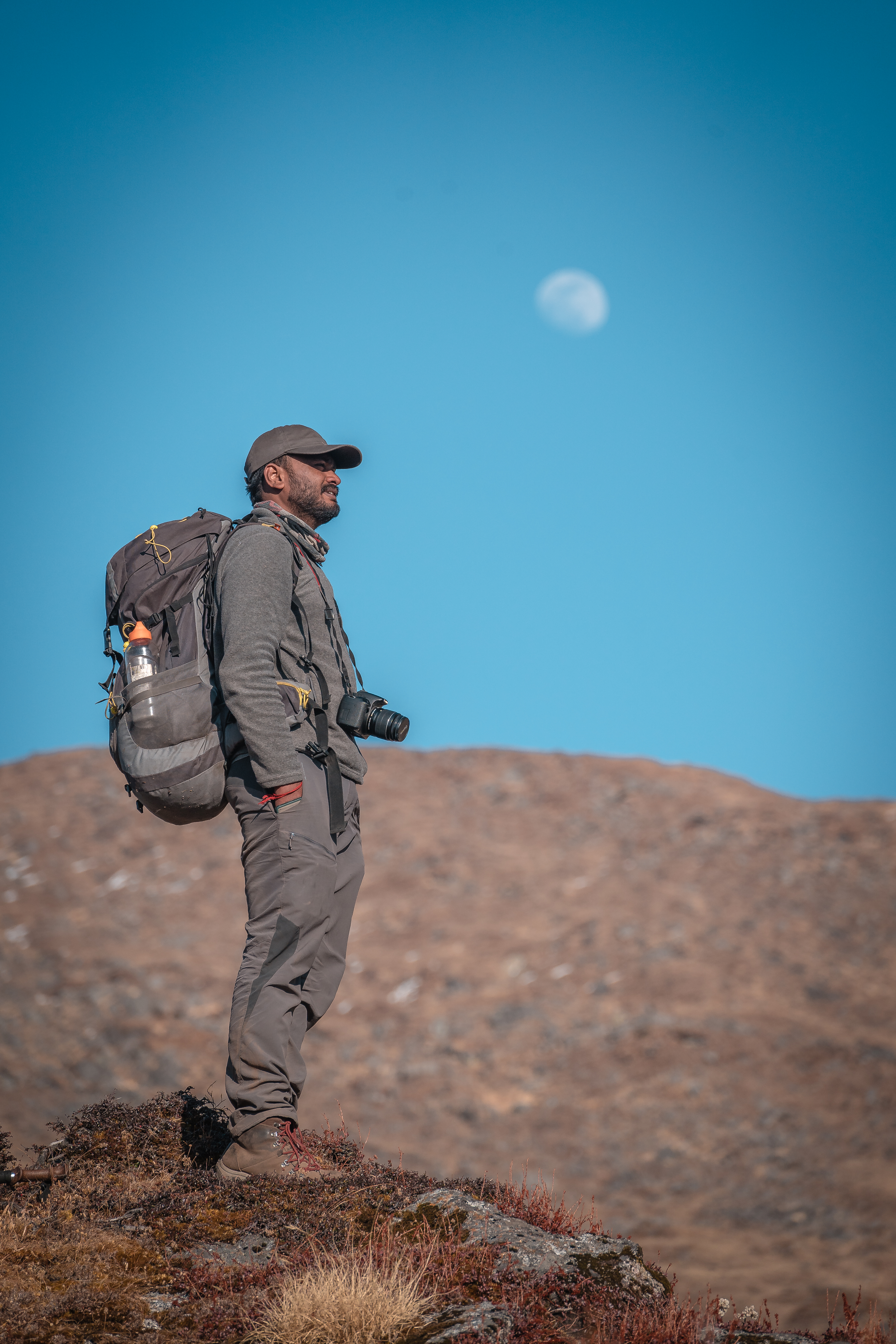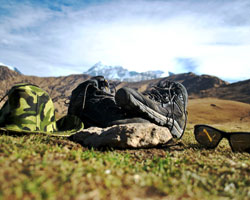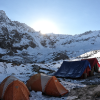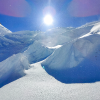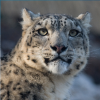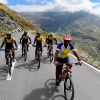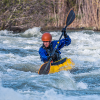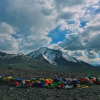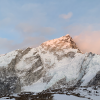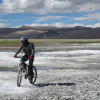The Snow Leopard Winter Expedition in Rumbak Valley, Ladakh, is one of the most distinct experiences for all wildlife fans and trekkers out there. It does not have the greenery of the grasslands, it does not carry the density of a tropical rain forest and it is not packed with the lush flora of the wetlands. Instead, it is a setup covered in dry valleys, frozen streams, and never-ending horizons marked by the silhouette of mountains.
The expedition is located in the Hemis National Park and happens during the winters in Ladakh, from December end to March end. These extreme weather conditions make this place an ideal abode for the fierce snowcats. Inside the national park, the Indus River branches out and runs through three valleys, Rumbak valley, Husing valley, and Tarbung valley. These pathways are usually frequented by the snow leopard during the winters to find fresh sources of food and to mate. During the peak season, trekkers and wildlife viewers from across the world come here to capture the grey ghost in action with their cameras.
About the Snow Leopard Expedition –
The Snow Leopard expedition is a 10-day program where you will be accompanied by an expert guide to tracking the leopard. Placed on the premises of the Hemis National Park, this trek happens in and around the Rumbak valley through which the beautiful Indus River flows. Here the temperatures drop down to -15 degrees in the day and -20 at night. The trails mostly contain 60-70 degree ascents and at the viewpoints, the winds blow at 60 km/hr. Other than the snow leopard, one can also spot other exotic wildlife like, Tibetan wolf, Golden eagle, Pika, Eurasian magpie, and Brown Fox.
In this article, we will be discussing the following topics to give you a wholesome idea of the Snow Leopard Expedition and what goes in it.
Topics –
- Facts about Snow Leopard
- Old leopards VS young ones
- Snow leopard and villagers in olden days and now
- How to spot a Snow Leopard?
- Landscape of Rumbak
- Winds of Rumbak
- Mannerisms to follow
- Equipment to use
- Other animals of Hemis National Park
- Communication
- Life of a Snow Leopard trek Guide
Interesting Facts about Snow Leopard –
- Did you know that snow leopards cannot roar? Instead, they let out a slightly muffled cry which experts have come to refer to as the silent roar.
- They have the biggest tail in the cat family.
- They don't have den-like tigers and lions. They keep changing their territory depending on the availability of food and mating sources.
- They walk more than 25 km a day and always follow the skyline.
- The snow leopards are highly elusive by nature and extremely hard to find. Spotting them is a relatively rare occurrence earning them the name, “Grey ghost of the Himalayas”.
- In the Ladakh region, Bharal and Blue sheep (Mountain goats) are favorite food sources of a snow leopard.
- The grey skin of the snow leopard often camouflages well with the landscape of Ladakh allowing them to move stealthily across slopes. They are also extremely agile and nimble on their feet allowing them to climb down 80-degree slopes silently.
- They are excellent leapers. Their long tail helps them to move with perfect balance.
- During the mating season, the female snow leopards pick a high conjunction point on the valley to call out for a partner. Their calls from these points can reach several kilometers.
- In a fight, the weaker ones roll their heads to submit.
- The average resting point of a snow leopard in a place after a hunt is one week. They have a weak heart by nature. Because of that, they save the meat for 2-3 days and consume them gradually.
- Snow leopards can carry prey 3 times their weight.
- Snow leopards chew on a local plant called UMBU. This helps them with indigestion and to clear their stomachs.
Old leopards VS young ones –
One can make out the age of snow leopards distinctly by their appearance and behavior. The young snow leopards are more ferocious by nature and have shiny fur coats on their body. They have a raw and refined taste for food. They often get into fights with other snow leopards over a partner or territory. These young ones are mostly found on high altitudes.
The older the snow leopard, the duller is its skin. The fur content also drastically reduces because of its age. They cannot hunt nimble prey. Often, they travel downwards to the river to find food sources. This increases the possibility of them entering villages located along the river and attacking the farms and cattle there.
Snow leopard and villagers in olden days and now
The relationship between a snow leopard and villagers has evolved over time.
In the olden days, the concept of hunting and killing snow leopards used to be a sport and a necessity for the villagers of Rumbak, Markha, and Ulley. The villages of Markha and Skiu especially were famous for their cattle and pashmina goats.
When a leopard hunted one of the cattle or pashmina goats, it majorly disrupted the life cycle of the locals. So they used to travel in groups, track the leopard and kill it with rocks and traps. This was the practice two centuries ago. As civilization progressed, rocks and traps were replaced by guns and metal traps.
All of this came to a halt 15 years back. Dalai Lama brought in awareness and put a stop to the hunting of snow leopards. Following this, wildlife organizations also brought in conservation schemes to maintain a balance between the villagers and the leopards.
- They began by creating an ecosystem that separated the spaces the villagers and snow leopards used. Different routes were marked and laid out, a systematic space for cattle and farming was allocated, and proper communication networks were established.
- Next, they brought in insurance and compensation policies. If a leopard attacked any of their cattle, the government compensated the villagers with money. The villagers could even insure their assets with rewarding returns.
- Lastly, they trained the villagers in hospitality and introduced the Homestay system that brought in alternate sources of income into the region.
These measures have worked over the years allowing the villagers to perfectly coexist with their grey ghosts.
How to spot a Snow Leopard –
Everything begins with a footprint. Depending upon the angle, depth, and elevation, the guide can predict a snow leopard’s age and direction.
Once a footprint is located, pugmarks are searched for in the area. The snow leopard loves leaving messages behind. They scrape the ground with both legs to mark their path. This alerts other leopards to stay away from that path.
The third step is to check for excreta. The excreta allow the guide to predicting a snow leopard’s recent food cycle. If the waste has some fur, then it means the snow leopard had hunted recently. If the fur is dry and broken, then it means that the leopard is still searching for a new hunt.
The main action to be considered are the pee marks. The leopards pinpoint a boulder rock, mark their territory by spraying urine on the signature rock and rub their neck on it. This is to show its dominancy over other leopards.
Check for the skyline ridge as well. Like all the predators of the cat family, the snow leopards also have a hangout spot. They love to walk on the top of the valley or peaks which meet the skyline.
Mornings and evenings are the best time to spot a snow leopard. The golden hour for the snow leopard is when the first light hits the land and during sunset.

The landscape of Rumbak –
The landscape here resembles the backdrop of the movie Interstellar. Holding an ice dessert on one side and a partially frozen Indus River on the other, the topography exudes an otherworldly aura. The hills adjacent to the valleys are steep and the trails are completely covered with hard sand, gravel, and boulders. Between the broken rocks and grey sand, you can find vibrant crops which act as fodder for the mountain goats.

The trek inside the Hemis National park begins at Tarbung valley, continues towards Husing valley, and ends at Rumbak valley. Tarbung and Husing are an extension of the Rumbak village and have a 360-degree viewpoint. At these viewpoints, the wind blows at 60 km/hr. Unlike treks where we are constantly on the move most of the time, we are required to stay still on the snow leopard expedition. Without movement, your body tends to get colder faster. So please ensure you are layered adequately.

Winds of Rumbak –
The winds of Rumbak can be deceptive. While blowing through the stones, crops, and hollow cracks, they produce different types of sounds. Some of these sounds resemble calls of animals. This could get confusing, especially near the viewpoints where you are required to keeps your eyes and ears peeled. So, when this happens, please ensure you consult with your guide immediately or scan the direction with your senses properly to get clarity.
Mannerisms to follow on the trail
Here are few things you will need to observe when you are on the snow leopard expedition –
- Stay still like a rock or a tree. A leopard can spot you from miles. If you are still, you can have more chances to spot them. Even if you have to move, do so slowly. Any sudden movement or noise can be disturbing for them.
- Patience is the key. Many people make the mistake of shuffling their positions and changing their field of vision often because of restlessness. Checking a particular spot for a long time can increase the possibilities.
- Shut your smartphones and speakers. Silence is the main factor in the forest. If you disrupt this with songs and electronic devices, it will ruin the stillness around and disturb the animals as well.
- Be alert and attentive. If you spot a small movement or even hear strange noise, tell your leader immediately. It could be something special like a kill or even a mating session. Being observant can unfold several colors and even fauna like the blue sheep, golden eagle, Himalayan rabbit, etc.
- Hydration is a must. Though you won’t travel or trek a lot, the dry atmosphere can drain the water content in your body. This might lead to headaches and fatigue. Proper hydration can prevent these discomforts.
Equipment to use –
Binoculars –
Bikat Adventures will be offering you a professional telescope for viewing. If you wish to bring your equipment then a binocular or a simple telescope will be ideal.
- Binoculars –
Source - https://www.worldbirds.org/best-binoculars-for-wildlife-viewing/
You can check the above link to get an idea of the type of binocular to buy. Alternatively, you can also consider renting them from eCommerce platforms/websites.
- Telescope –
Source - https://www.digitalcameraworld.com/buying-guides/best-spotting-scope
You can check the above link to get an idea of the type of telescope to buy or check some eCommerce platform/other websites for rental purposes.
A small tip on using equipment:
Using a scope or a binocular comes with the 20-20 rule. The continuous strain of the cornea can trigger nausea, eye irritation, and even giddiness. After every 20 minutes, ensure you take a break for another 20 seconds or more before starting again.
Other animals of the Hemis National Park –
Snow leopards are not the only fauna that calls the Hemis National Park home. Keep your eyes peeled for these animals as well while looking through the scope/binoculars.
Golden Eagle, Eurasian Magpie, Lammergeier, Red Fox, Himalayan Rabbit, Pika, Blue Sheep, Chukar Partridge, etc.

Golden eagle

Eurasian Magpie

Lammergeier

Blue Goat
The importance of Communication on the Snow Leopard Expedition
One of the main factors of the Snow Leopard expedition is effective communication. To cover more ground and to deploy extra eyes, the guide and supporting staff will be scouting different areas. Anything can appear anywhere requiring one team to catch up with the other team immediately. For this, instant communication is a mandate. To tend to this need, the staffs use an advanced walkie-talkie with maximum range coverage and long battery life.
Life of a Snow Leopard Expedition Guide –
As narrated by Rigzin Tamchos from Skiu, Markha Valley. He is the Snow Leopard guide of Bikat Adventures.
Being a local from Ladakh, I have seen every corner of this forest and every stone knows my name.
In ancient times, meeting a snow leopard was not that rare. We knew the exact techniques to track the untamed and spot the unseen. My professional journey in wildlife might have begun a decade ago. But my connection with them started from my home.

- Training –
A few decades back, there was no means of transportation. Ladakh was completely covered by ice and wilderness. We used to meet our family members once in three months. This is because it takes several days to reach the destination and there was no way to pass on a message. Everything was primitive, yet detailed with serenity and peace. The National Park was replete with wildlife back then. So saving our sheep and horses from the Tibetan wolf or Snow Leopard was a herculean task. My grandfather and I used to take turns in the night to keep watch. My grandfather could gauge the nature of the animals, just by the sounds of their footing. Taking a different trail, making huge noises, and lighting a fire were the only defense mechanisms we had in the olden days.
Later, when I eventually joined a wildlife organization to help them in their tasks, I underwent proper training. I used to spend hours in the valley (read 10-11 hours) and was taught a lot about tracking life forms.
Initially, everything looked the same. After a few months of observations though, I had gotten accustomed to noticing the life forms and the habitat around them. Having spent several years in the field, I can now understand their behavior and actions in detail. So, it is not just the snow Leopard, the art of spotting a life form here is an acquired knowledge that we have cultivated and perfected for years.
- While spotting –
The nature of our work is different from other adventure activities.
First, a leader has to get up before dawn around 4 AM. Then he or she has to head towards the base of a particular valley and even out the terrain to get clear footprints. Then after waiting for the first light, they have to check for the pug marks which could be fresh or a few days old. Depending upon the marks, the leaders then have to ascend and scout for urine markings.
If they get a fresh stench or find a tiny hair stuck on some signature rocks (Snow leopards like to rub their necks on rocks to leave a message), they have to calculate the distance and time, and then take the participants with them.

After taking the participants to a viewing point, the leader then has to set the scope or binoculars at the right angle for a proper scan which could go on for several hours.
- Luck –
In my experience through the years, I have met the elusive cat in the most unpredictable times. 4 -5 years ago, I was assisting a professional wildlife explorer from Germany. We had spent 2 months looking to capture some good moments of the beast. But our luck was so slim that we couldn't even spot a footprint.
Recently, when I came with a few first-timers, we not only spotted the snow leopard but even got to witness a proper kill. The participants were ecstatic with their experience.
So, lots of luck is also needed on this expedition. There is a chance you may spot a snow leopard. There is also a chance that you might come back empty-handed. The trick here is to enjoy the process. Because you will never experience a landscape like this anywhere else in India.

From the above topics, we hope you have gotten comprehensive insights into the Snow Leopard Expedition and the conditions that go with it. In case you have any other queries, feel free to give us a call on our helpline number below.
Pre-booking: +91-8448680062
